Do you know when to use a crystal or an oscillator? The wrong answer can cost you.
Have you ever thought about the total cost of using a crystal versus a MEMS oscillator? This question may not be at the forefront of your selection process when the price of crystals seems so cheap—at least on the surface. But although the unit cost of crystals is generally lower, once the total cost is calculated, the picture looks much different.
3 Common Crystal Design Issues
At SiTime, we hear from many customers when they have crystal design issues such as cold startup failures, oscillator circuit problems from mismatched crystals, or failure to pass EMI tests. These problems cause engineering cost overruns during development and can create costly quality issues. Plus delaying the product release date equates to lost revenue. Here we share three situations where customers came to SiTime to decrease their overall cost of ownership when facing crystal design concerns.
The difference between a crystal vs an oscillator
But first let’s briefly cover the basics … what is the difference between a crystal (XTAL) and an oscillator (XO)? In simplified terms, a crystal (sometimes called a resonator) is a moving/resonating passive component [1] that connects to an external oscillator circuit in the chip that it is timing, like an SoC, microcontroller or processor—as shown below on the left.
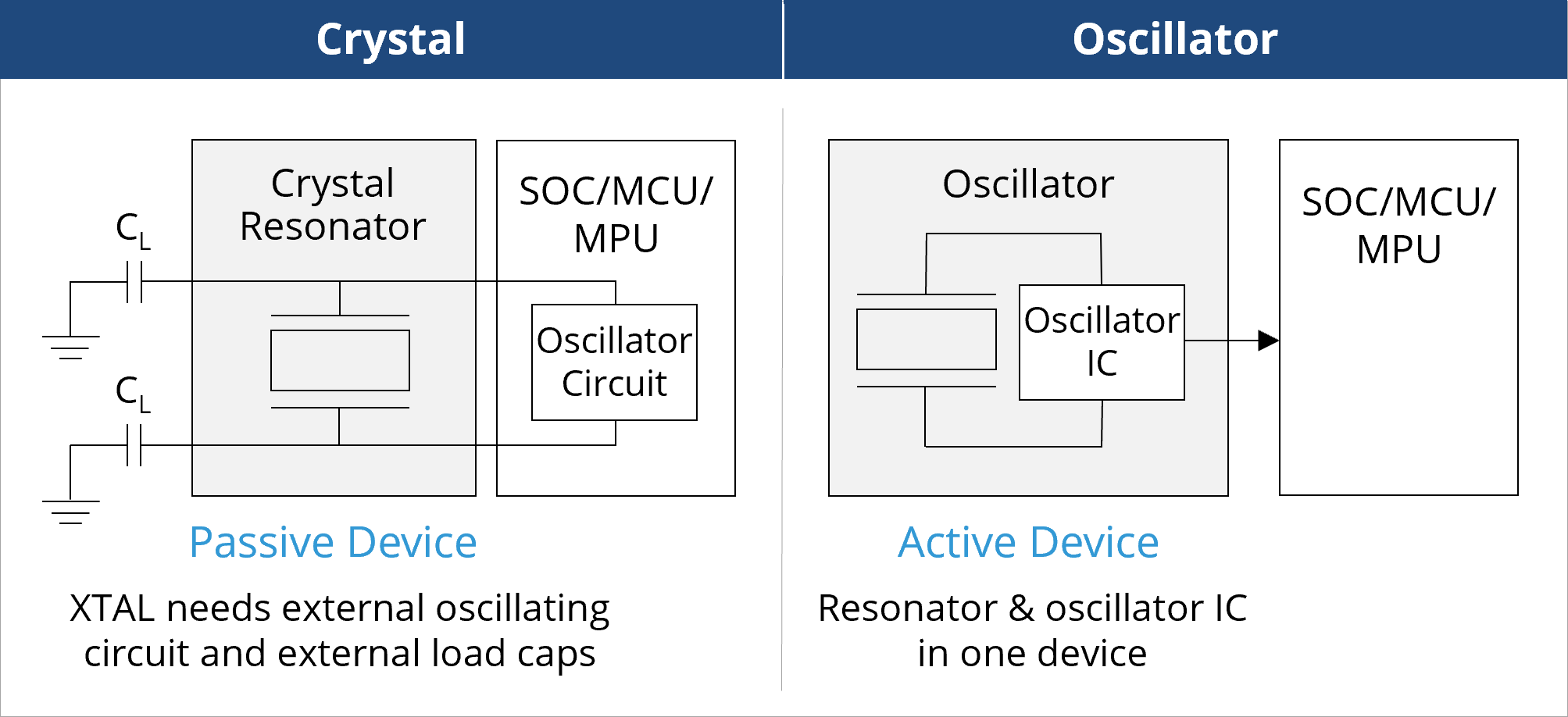
An oscillator, shown on the right, is an integrated timing solution that contains both a resonator and an oscillator IC, in one active device. In the case of SiTime oscillators, the resonator is based on silicon MEMS (micro-electro-mechanical systems) technology instead of a traditional quartz crystal. This architecture enables robust “plug-and-play” oscillators that are flexible and very easy to design into a system.
Total cost of ownership
Oscillators are easier to design into a system since they include functionality and features that solve common and often difficult timing design problems. We’ve laid out some total cost examples which are based on pricing from Digi-Key and SiTimeDirect for XTALs and XOs with the same output frequency, stability, and package size [2]. Then we add the cost of the engineering workhours (based on $100 per hour) that is required to remedy the problem.
Each case has a different breakpoint based on production volume and engineering time. In general, the cost of designing with a crystal is lower when quantities are very high and design costs are amortized over large volumes. Conversely, the cost of using an oscillator is lower when quantities aren’t in the tens of thousands. But there’s more to the story.
What’s NOT factored into the following examples is the opportunity cost (lost revenue) due to project design delays, which can be tremendous in some markets. In some cases, there are additional costs for outside services and testing—and these can also be significant. Plus there are other penalties that add up. These include items such as the expenses for additional materials and components needed for board re-spins, the cost of load capacitors that are required with crystals (and not with oscillators), and the additional board space consumed by the capacitors—all of which further tilt the equation toward using an oscillator.
For simplicity sake, in the following examples we’ve included ONLY the cost of the timing component and the engineering time to correct the crystal problem.
1. Cost of crystal vs oscillator – cold startup failure
Unlike crystals, MEMS oscillators do not have startup problems. In this customer case, 15 hours of engineering work was required to correct the crystal startup problem. Here, with a relatively quick fix, the cost benefit of using a MEMS oscillator is realized when production volume is around 6,500 units or less. In other words, unless you are manufacturing in very large volumes, you could be paying more for a crystal in the long run.
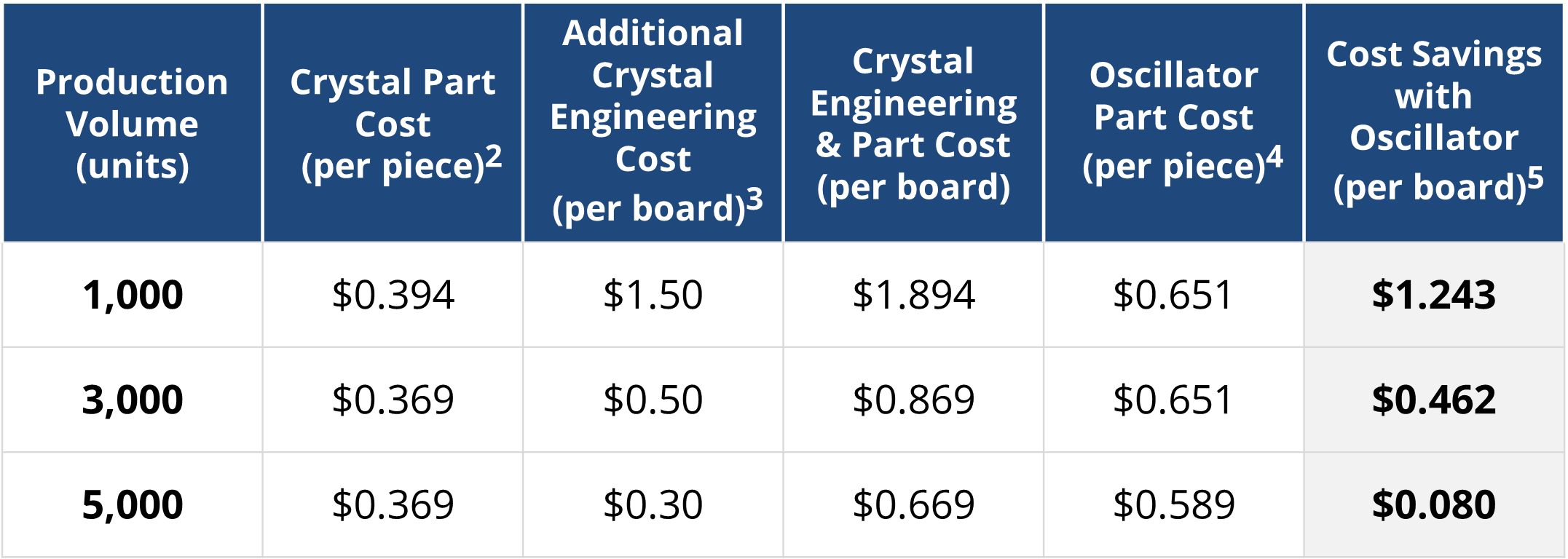
2. Cost of crystal vs oscillator – mismatched crystal causes oscillator failure
Because oscillators are an integrated solution (combining the resonator and oscillator IC in one package), matching errors are eliminated. Designers don’t need to worry about crystal motional impedance, resonant mode, drive level, oscillator negative resistance, or other pairing considerations. In this customer case, 40 hours of engineering work was required to correct the matching issue, making it less expensive to use an oscillator at volumes of around 17,000 or less.
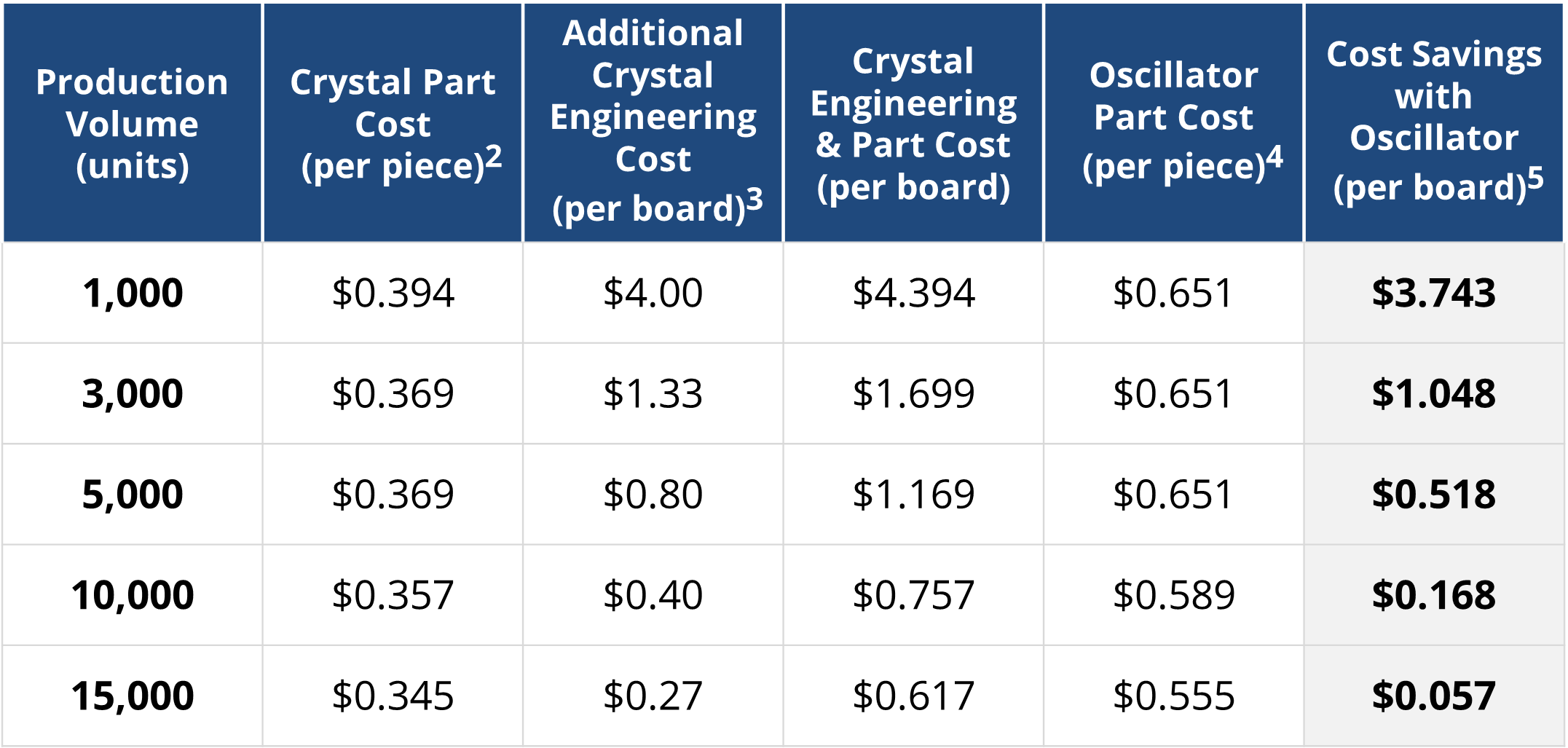
3. Cost of crystal vs oscillator – EMI compliance failure
The clock is often the largest contributor to EMI (electromagnetic interference) in a system and it can cause a prototype to fail compliance testing. SiTime MEMS oscillators offer multiple techniques for quickly and easily reducing EMI. One such technique is spread spectrum clocking. Another feature is FlexEdge™, a programmable feature for adjusting the rise/fall time (slew rate) of the clock signal to lower EMI.
As a passive component, crystals don’t have these EMI-reduction features. If designers need to use shielding or add a spread spectrum clock generator IC with their crystal, this adds expense and board space. Plus renting an anechoic chamber for additional testing could incur another $3,000 or more. To redesign the board and retest, it can take 50 hours of engineering work, making it more beneficial to use a MEMS oscillator at volumes of around 23,500 or less. And this doesn’t include the additional materials and test facility costs mentioned above.
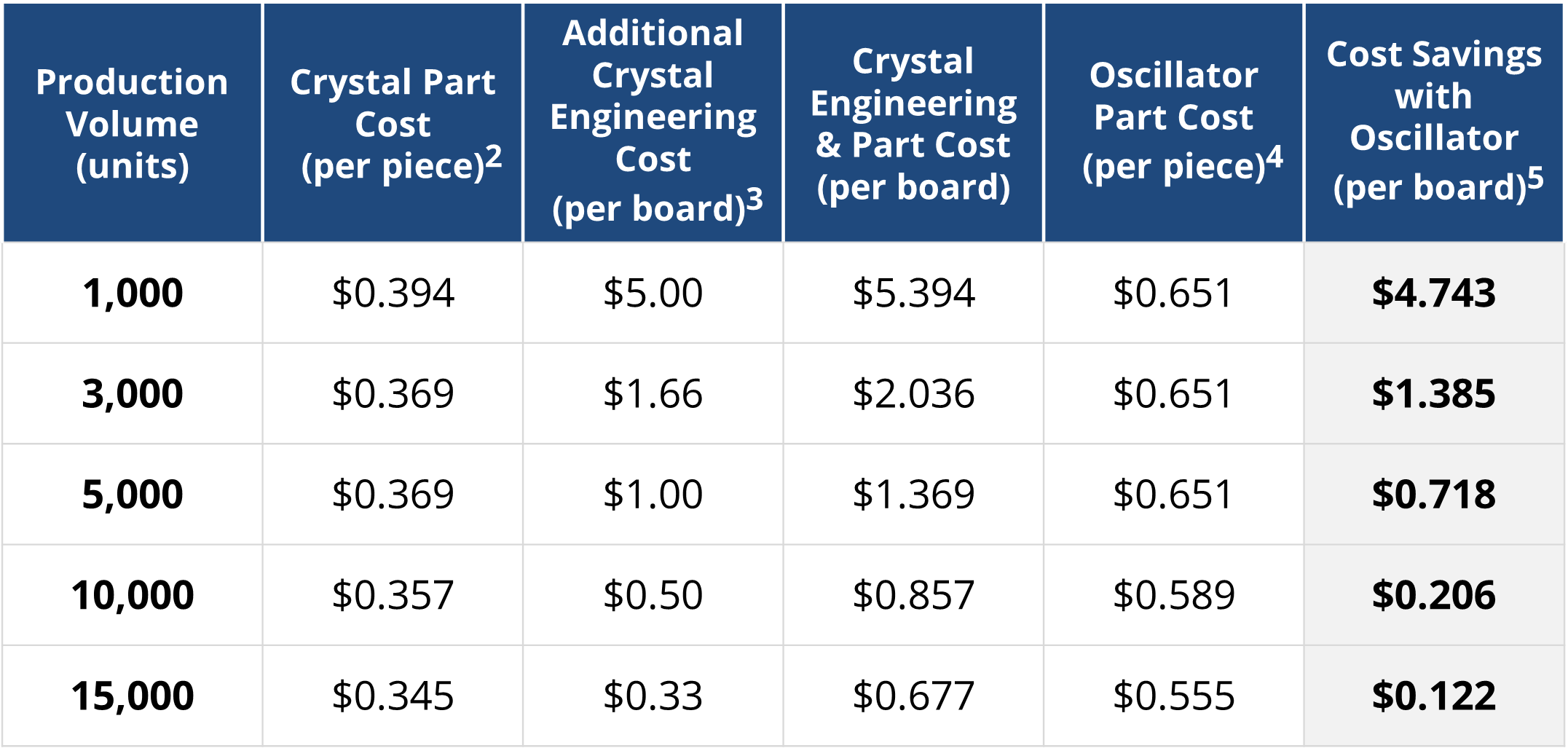
Bottom line – savings across the board
In addition to direct costs, there are other factors that affect the cost of designing with crystals. For example, oscillators can drive multiple loads. That means one oscillator can replace multiple crystals, which can provide a timing signal for only one device.
Additionally, SiTime MEMS oscillators are based on a programmable architecture that makes them readily available in any frequency, stability, and voltage within a very wide range. This provides great flexibility for designers to optimize their design. In fact SiTime oscillators can be programmed by key distributors or even by customers in their own lab using the Time Machine II.
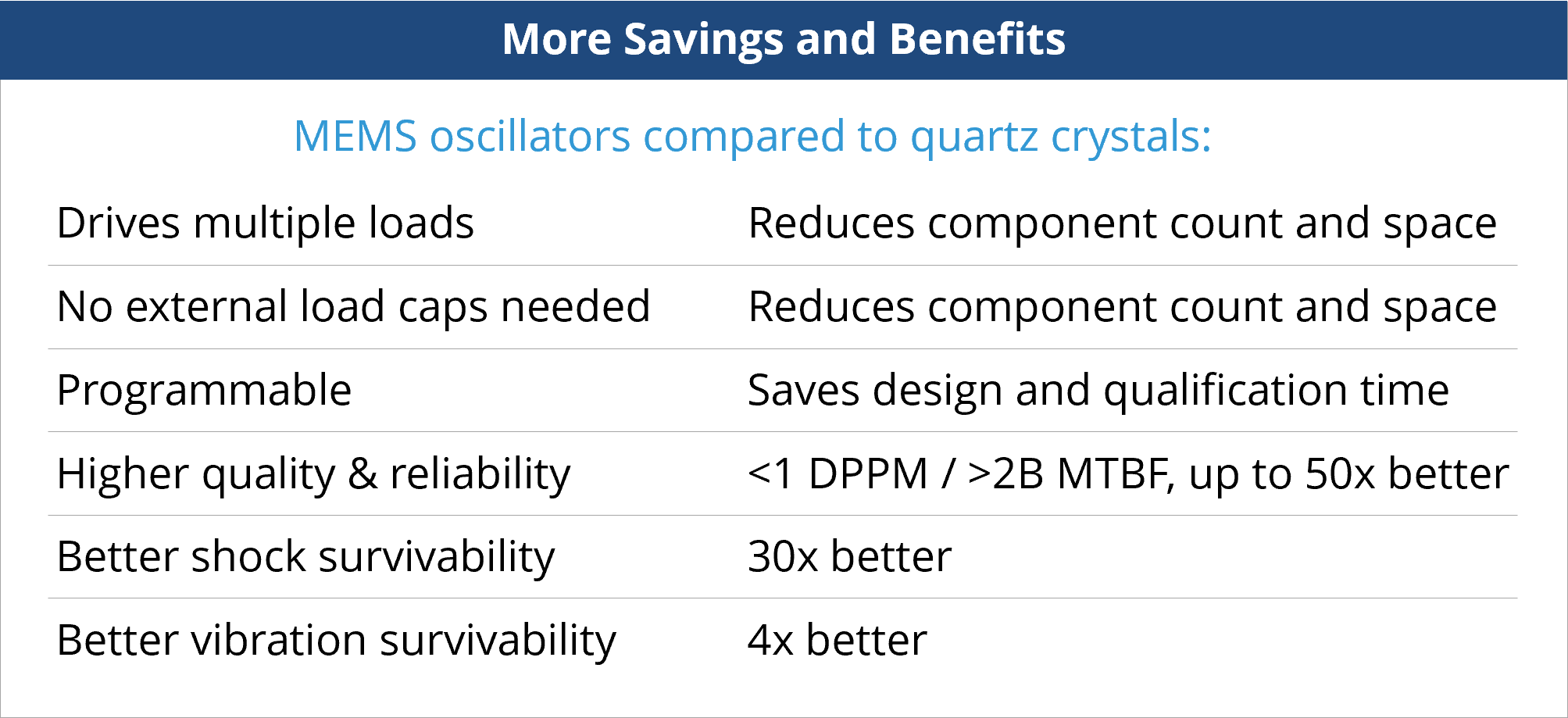
Programmability can also reduce the cost of qualification efforts if specification changes are needed. This cost- and time-saving benefit is possible because a MEMS oscillator (before programming) can generate millions of part numbers. Once the base part is qualified it can be configured to support a huge variation of specifications.
Perhaps one of the biggest indirect savings comes in the form of higher quality and reliability. SiTime MEMS oscillators have less than 1 DPPM and over 2 billion hours MTBF (mean time between failure) compared to typical quartz devices, which is up to 50 times better. Plus, SiTime MEMS oscillators have much better survival rates against shock and vibration compared to quartz crystals.
The higher failure rates of quartz crystals can increase costs in many ways, such as the added resource costs for root-cause analysis or extra service and replacement costs. And, the damage that quality issues do to a brand’s reputation can have a huge and long-lasting negative effect on a company’s bottom line.
Using an oscillator in place of a crystal can lower costs in many ways. Why not skip all the headaches and extra expenses, and use an oscillator? When procurement is focused on lowering component costs, remember that looking at the big picture will ultimately save in the long run. To learn more about the benefits of oscillators beyond cost, read our white paper: The top 8 reasons to use an oscillator instead of a crystal resonator.
……………………………………………
References:
[1] ESC Components: Active & Passive Components - What Is The Difference Between The Two?
[2] Based on Digi-Key pricing as of February 23, 2023 for a ABM8W-25.0000MHZ-4-D1X-T3 crystal with 25 MHz frequency output, ±20-ppm frequency stability and ±10-ppm initial frequency tolerance, 3.2 x 2.5 x 0.75 mm package, -40 to 85°C operating temperature.
[3] Based on $100 per workhour.
[4] Based on SiTimeDirect pricing as of February 23, 2023 for a SiT1602BI-21-YYS-25.000000 oscillator with 25 MHz frequency output, ±20-ppm frequency stability, 3.2 x 2.5 x 0.75 mm package, -40 to 85°C operating temperature.
[5] Difference in cost between using an oscillator compared to a crystal passive component with similar specifications and with engineering time included.
……………………………………………
Related Blogs:
Custom Programming SiTime MEMS Oscillators at Digi-Key
Top supply chain benefits of programmable timing
Top size and power saving benefits of programmable timing
Capacitor shortage? Use oscillators – they don’t need caps
How to Solve Costly Design Problems with EMI Reduction
SiTime Oscillators Replace Discontinued Murata Resonators, While Upgrading System
Related Course:
Related White Paper:
The top 8 reasons to use an oscillator instead of a crystal resonator
Related Products: